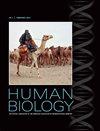从语言学、考古学和遗传学的角度看奥斯特罗西亚语的起源和传播
4区 生物学
Q2 Medicine
引用次数: 0
摘要
奥斯特西亚语(AA)是东南亚大陆(MSEA)和南亚的一个大语系。由于理论、方法和材料方面的限制,在历史比较语言学中,对说 AA 语的人群的起源和散布的研究受到了限制。我们回顾了语言学、考古学和分子人类学的最新假说,并对 AA 语言的起源和传播提出了见解。我们认为 AA 语人群的祖先是生活在中国南方新石器时代的稻农。在公元前 3,000 至 4,500 年之间,这些说原 AA 语的祖先中的一些人带着肩扛石器和驯化的水稻从中国南方迁徙到越南北部。他们与当地的狩猎采集者混合,向澳门金沙线上领彩金网南方扩展,产生了孟高棉人、阿斯利安人和尼科巴雷人。他们还扩散到印度东北部,形成了讲孟达语的人群。另一支大约在公元前 2500 年到达云南滇池附近,他们在那里与讲原泰加泰语(TK)的人群一起创造了铜鼓文化,后来经广西向东传播到越南北部。最后,留在华南的讲原 AA 语的人与来自福建和广东的讲原 TK 语的人群混合,导致了语言的转变,我们推测这是 AA 在华南 "消失 "的主要原因之一。本文章由计算机程序翻译,如有差异,请以英文原文为准。
The Origin and Dispersal of Austroasiatic Languages from the
Perspectives of Linguistics, Archeology, and Genetics
The Austroasiatic (AA) languages comprise a large language family in mainland Southeast Asia (MSEA)
and South Asia. Theoretical, methodological, and material constraints have limited research on the origin
and dispersal of AA-speaking populations within historical-comparative linguistics. With the deepening of
archaeological and genetic studies, interdisciplinary collaboration has become key to solving this problem.
We review the latest hypotheses in linguistics, archaeology, and molecular anthropology and propose
insights on the origin and dispersal of AA languages. The ancestors of the AA-speaking populations were
suggested to be rice farmers living in the Neolithic Age in southern China. Between 3,000 and 4,500
BP, some of these ancestors who spoke Proto-AA migrated from southern China to northern Vietnam,
together with shouldered stone tools and domesticated rice. They mixed with local hunter-gatherers and
expanded to the south of MSEA, giving rise to the Mon-Khmer, Aslian, and Nicobarese populations. They
also spread to the northeast of India to form the Munda-speaking populations. Another group arrived
near Dian Lake in Yunnan about 2,500 BP, where they created the Bronze Drum culture with the Proto-
Tai-Kadai (TK)–speaking populations and later spread eastward to northern Vietnam via Guangxi. Finally,
the Proto-AA–speaking people who remained in southern China mixed with the Proto-TK–speaking
groups from Fujian and Guangdong, leading to a language shift, which we hypothesize was one of the
main reasons for the “disappearance” of AA in southern China.
求助全文
通过发布文献求助,成功后即可免费获取论文全文。
去求助
来源期刊

Human Biology
生物-生物学
CiteScore
1.90
自引率
0.00%
发文量
88
审稿时长
>12 weeks
期刊介绍:
Human Biology publishes original scientific articles, brief communications, letters to the editor, and review articles on the general topic of biological anthropology. Our main focus is understanding human biological variation and human evolution through a broad range of approaches.
We encourage investigators to submit any study on human biological diversity presented from an evolutionary or adaptive perspective. Priority will be given to interdisciplinary studies that seek to better explain the interaction between cultural processes and biological processes in our evolution. Methodological papers are also encouraged. Any computational approach intended to summarize cultural variation is encouraged. Studies that are essentially descriptive or concern only a limited geographic area are acceptable only when they have a wider relevance to understanding human biological variation.
Manuscripts may cover any of the following disciplines, once the anthropological focus is apparent: human population genetics, evolutionary and genetic demography, quantitative genetics, evolutionary biology, ancient DNA studies, biological diversity interpreted in terms of adaptation (biometry, physical anthropology), and interdisciplinary research linking biological and cultural diversity (inferred from linguistic variability, ethnological diversity, archaeological evidence, etc.).
 求助内容:
求助内容: 应助结果提醒方式:
应助结果提醒方式:


